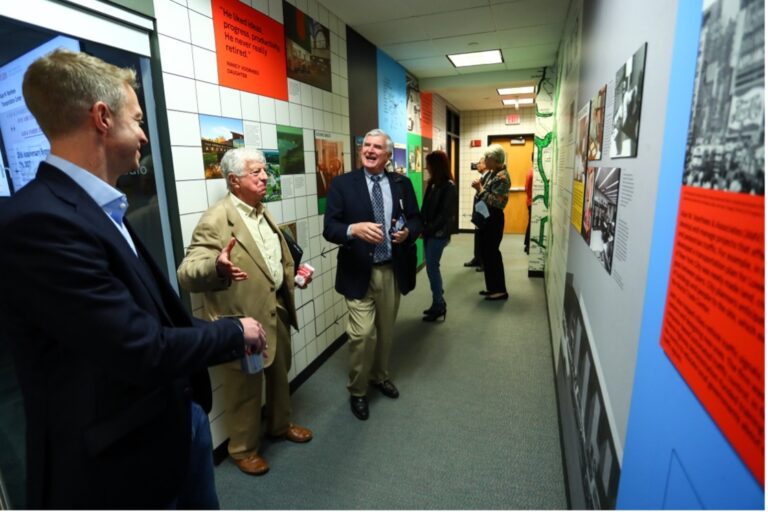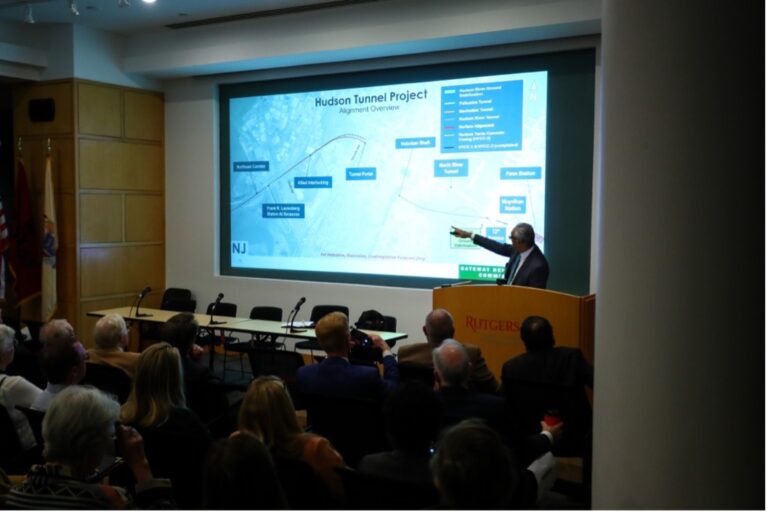The Alan M. Voorhees Transportation Center celebrated its 25th anniversary this month with remembrances of a transportation visionary along with an update on the Gateway Program (one of the most expensive transportation projects in the U.S).
The Voorhees Transportation Center, housed within New Jersey’s Rutgers University, conducts research, delivers training and education programs, and provides technical assistance on a range of critical transportation planning and policy issues. Three projects currently on its plate include improving access to a light rail line, evaluating post-pandemic travel behavior changes, and helping communities prepare for automated vehicle technology. The Center includes the National Transit Institute, an organization created by Congress to provide training and education programs for the U.S. transit industry.
The Center has received funding from numerous sources over the years including the Federal Highway Administration, Transportation Research Board, New Jersey Department of Transportation, and the Port Authority of New York and New Jersey. It also had a remarkable and generous benefactor. Alan Voorhees, who grew up only a few miles from Rutgers University, was among the first transportation professionals to predict travel patterns by using the gravity model. He went on to shape the development of the interstate highway system, founded a consulting firm with 16 offices, and then helped start an airline and a company that pioneered hybrid rocket propulsion.
Many of those who knew Alan Voorhees referred to him as a visionary. That is obvious in a 1962 article he wrote in Eno’s Traffic Quarterly where he discussed the rapid economic, social, technological and public policy changes that were affecting transportation. His conclusion is just as relevant today as it was more than 60 years ago: “The urban transportation problem that we all face is much too big for anything but the most comprehensive and searching analysis. Only if we rationally assess the social, economic and technological changes that will be taking place can we guide public action so as to secure the full benefits of transportation and community planning for all people living in urban areas.”
Although the Voorhees Center is well-known in the New York metropolitan area, its work tends to be under-recognized nationally and internationally. It is often overshadowed by U.S. DOT funded research centers that are part of the University Transportation Center program such as the Mineta Transportation Institute in California and the Center for Urban Transportation Research in Florida.
The Voorhees Center has a proven track record, though, with a website that hosts invaluable resources (including reports, plans and oral history archives). The Center’s team includes more than 25 full-time research staff as well as affiliated faculty. In a recent five-year period, they published more than 100 peer-reviewed journal articles and more than 250 other project-related publications.
An Update on Gateway
At the Center’s 25th anniversary celebration, Kris Kolluri, the CEO of the Gateway Development Commission and a Rutgers University alumni, updated the Voorhees Center’s friends on the Gateway Program.
One piece of the program is a new 2.4-mile-long rail tunnel that will be built under the Hudson River connecting New Jersey and Manhattan. Currently, about 200,000 people a day ride trains on two tracks under the river. The existing rail tunnels – deteriorating, badly damaged in a hurricane, and over 100 years old – will also be rehabilitated as part of the Gateway Program.
The tunnel project is critical for improving service on Amtrak’s Northeast Corridor (between Boston and Washington D.C.) and for New Jersey Transit’s service between New Jersey and New York’s Penn Station. Kolluri did not emphasize the project’s capacity enhancing features, but rather fashioned the initiative as a resiliency project that will eliminate a vulnerable point of failure for the region and corridor.
The tunnel project is slowly moving along the federal approval process on its way to a full-funding grant agreement. The environmental impact statement was completed in 2021, and the governors of New Jersey and New York agreed to split the local share of the project’s cost. The Commission is now waiting federal approval to enter into the engineering phase. Kolluri said he’s hoping to announce progress about that approval “in the not-too-distant future.” He is well aware of the fate of the Gateway Program’s predecessor — the Access to the Region’s Core project was also waiting to enter the engineering phase when it was canceled in 2010.
Kolluri said the tunnel project is “unbelievably complex” with an aggressive schedule that will lead to completion in 2038. Although tunneling is scheduled to be completed in 2029, extensive work must then be undertaken for tracks, life safety systems, communications systems, and other components.
The cost of the tunnel is now estimated at $14 billion with about 50% federal funding. Kolluri said one lesson from Boston’s Big Dig project is that you have to be candid about costs, otherwise if project costs start to rapidly escalate, “it looks like you don’t know what you’re doing.”
He is hoping to get more than $7 billion in federal funds to reduce New Jersey and New York’s contribution. Referring to the different pots of money within the Bipartisan Infrastructure Law, he said, “We’re going to take a vacuum cleaner to the federal budget.”





